Living in Western Washington and saw some birds but are not sure which ones they were?
Washington is known for its wildlife and according to the Washington Bird Records Committee (WBRC), there are over 520 species of birds in the state!
Examples of birds of Western Washington include the tree swallow, house finch, American goldfinch, yellow warbler, osprey, Caspian tern, and many others.
Songbirds like the spotted towhee and the American robin, raptors like the bald eagle and barn owl, woodpeckers like the Northern flicker, ducks like the wood duck, and other birds are also common in Western parts of Washington.
Some of these birds, like the barn owl and spotted towhee, will stay year-round there, while others, like the tree swallow, will migrate south when the winter comes.
Here are their photos and some fun facts.
Table of Contents
Birds Of Western Washington
Tree Swallow
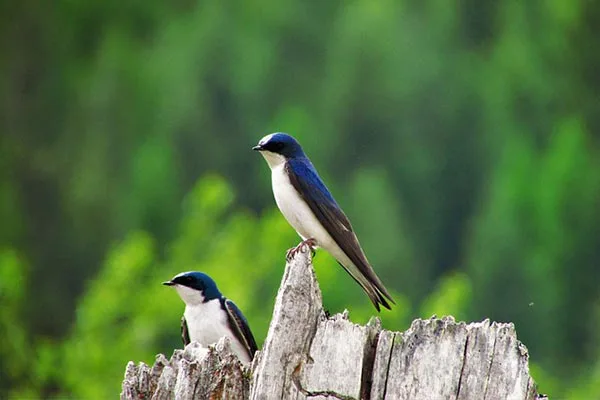
- Scientific name: Tachycineta bicolor
- Lifespan: 3 years
- Wingspan: 12-14 in
Tree swallows are small migratory swallows that are iridescent blue above, white below, and have dark faces. You will recognize these blue and white birds by their long, pointed wings and short, squared, or slightly notched tails.
These small songbirds are a welcoming sign of spring in much of North America.
Tree swallows can be seen in Western Washington during summer when they breed. When the fall comes, they will migrate south to winter in Southern US, Central, and South America.
They are social animals whose flocks can include thousands of birds.
If you decide to try to identify this species, the best habitats to start your quest will be near water, in open spaces such as wetlands or farm fields.
Listen for tree swallows’ song, a cheerful series of liquid twitters that consist of three parts: the chirp, the whine, and the gurgle.
They are omnivores that feed on insects, mollusks, spiders, and occasionally on fruit, berries, and seeds.
Red-breasted Nuthatch
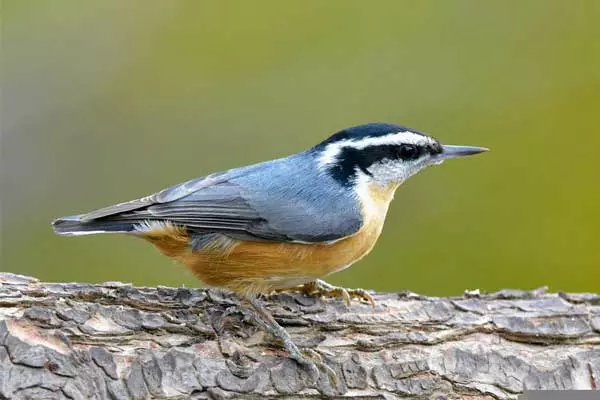
- Scientific name: Sitta canadensis
- Lifespan: 6 years
- Wingspan: 8.5 in
Red-breasted nuthatches are small songbirds with blue-grey upperparts, cinnamon-orange underparts, white throats, and black stripes over the eyes. They have straight gray bills, long toes and claws, white eyebrows, and black crowns.
Red-breasted nuthatches are permanent residents in Western Washington and can be seen in the state year-round around coniferous woods and mountains.
You can also recognize them by their high-pitched, nasal, and weak “yank-yank” call.
Red-breasted nuthatches are omnivores and mainly feed on insects and seeds, especially from conifers. They will also hoard excess food by wedging nuts into the bark and then hammer them in with their beaks.
Spotted Towhee
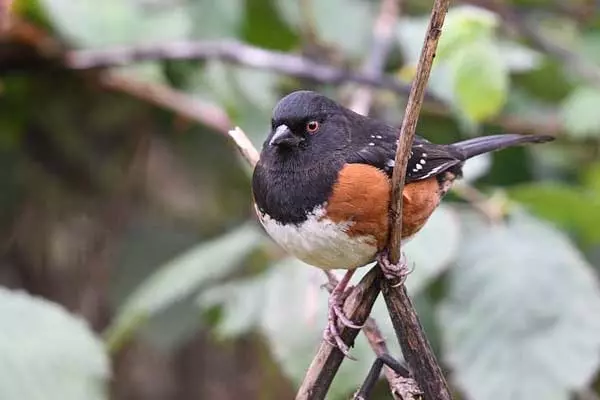
- Scientific name: Pipilo maculatus
- Lifespan: up to 12 years
- Wingspan: 11 in
Spotted towhees are large, striking, and long-tailed sparrows that have black hoods, black backs and wings that are speckled with white spots, rufous flanks, and white bellies and tail tips.
They also have bright red eyes and dull pink legs. Females are similar to males but are dark brown and gray instead of black.
Spotted towhees can be seen throughout the year in western parts of Washington. They are widespread in forest and woodland underbrushes.
These birds love to nest on the ground or low in bushes. They will often jump forward with their heads and tails up and kick their legs backward.
If you look closely, you might spot one hopping along the ground, scraping away leaf litter, and looking for insects, beetles, spiders, acorns, seeds oats, and berries.
They are also common around bird feeders so you might be lucky to find a spotted towhee around one.
Varied Thrush

- Scientific name: Ixoreus naevius
- Lifespan: 5-6 years
- Wingspan: 13-17 in
Varied thrushes are beautiful blue and orange songbirds. Males are slaty blue-gray above, orange below, and have black chest bands, orange wing bars, and orange eyestripes. Females look similar but have a slightly duller pattern.
Varied thrushes are permanent residents of Western Washington and can be seen there throughout the year in all forest zones, except the urban areas around Puget Sound.
They are famous for their amazing songs – a series of loud, ringing notes that can be heard in the thick, damp, mossy coniferous forests they inhabit.
Varied thrushes are often very aggressive toward each other and other bird species. They are omnivores and primarily feed on insects, seeds, and berries.
Western Tanager

- Scientific name: Piranga ludoviciana
- Lifespan: up to 8 years
- Wingspan: 11.5 in
Western tanagers are medium-sized songbirds that have pale, stout pointed beaks, yellow underparts, and light wing bars.
Males are hard to mistake for other birds and have red heads, yellow bodies, black wings and tails, and yellow shoulder bars. Females have yellow heads, olive backs, and dark wings and tails.
Western tanagers are widespread in forested habitats of Western Washington and can be seen there from spring to fall when they breed in the state. The best time to see them is from May to August.
They start migrating around September to winter from central Mexico to Costa Rica, usually alone, in pairs, or in groups of up to 30 birds.
Western tanager’s scientific name “ludoviciana” is a Latin word for “Louis” or “Louisiana” and refers to the 18th-century French colony in North America, not the modern US state.
These birds are omnivores that feed on insects, fruit, flower nectar, and berries.
Western tanagers are monogamous and breed from May to July. They have a clutch of around 4 eggs and both partners participate in raising the chicks.
Dark-eyed Junco
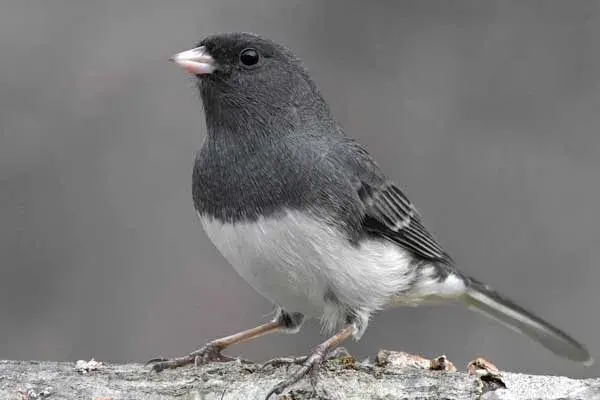
- Scientific name: Junco hyemalis
- Lifespan: 3-11 years
- Wingspan: 7.1-9.8 in
Dark-eyed juncos are a group of small New World sparrows. These tiny black birds can weigh less than an ounce and be as little as 5 inches long.
You will identify dark-eyed juncos by their rounded heads, short beaks, and fairly long tails. They are black above, their head is dark, their bellies are white, and their beaks are pale. Males tend to be darker colored than females.
Dark-eyed juncos are common throughout the year in Western Washington and can be seen around woodlands, brushy fields, parks, and thickets, except in high altitudes and dense forests.
They often forage while hopping and running on the ground and might even scratch the ground/snow with their feet in pursuit of food.
Dark-eyed juncos are nicknamed “snowbirds” because they’re commonly sighted in winter throughout North America.
They are omnivores that mainly feed on seeds, and some insects in summer.
There are 15 subspecies of dark-eyed juncos. Out of the two forms that appear in Washington (Oregon and the Slate-colored), the darker Oregon form is more common.
American Robin

- Scientific name: Turdus migratorius
- Lifespan: 2 years
- Wingspan: 12-16 in
American robins are one of the most widely distributed backyard birds of Western Washington. They are common around forests, parks, woodlands, and gardens of the state.
These large songbirds have a population of over 370 million birds in North America. Males can be identified by their black heads, yellow beaks, and brick-red breasts, while the females are slightly duller and have brown heads.
Outside of the breeding season, American robins like to form large flocks of birds, sometimes up to 10,000 individuals.
Their song is described as a “cheery” carol; these birds will also sing when storms approach and when they have passed.
American robins are the state birds of Connecticut, Michigan, and Wisconsin.
They are omnivores that feed on invertebrates, especially earthworms, and fruit.
American robins start nesting in Washington in early spring in lowland areas and later at higher elevations. They will produce 2-3 clutches of 3-4 light blue eggs per year.
American Goldfinch
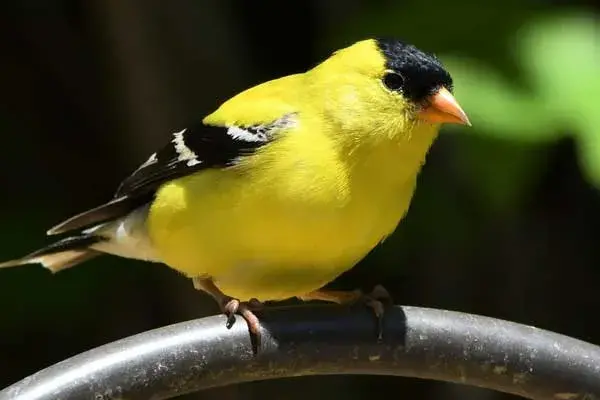
- Scientific name: Spinus tristis
- Lifespan: 3-6 years
- Wingspan: 7.5-8.7 in
The American goldfinch has been the state bird of Washington since 1951.
It is also the state bird of New Jersey and Iowa.
American goldfinches are small migratory finches with small heads, long wings, and short, notched tails. They were nicknamed “wild canary” because of their bright yellow plumage.
Males have a bumblebee pattern when nesting, orange beaks, black foreheads, and white bars over their black wings. During the winter months, males get an olive color while the females become dull yellow-brown.
American goldfinches are permanent residents of Western Washington and can be seen in the state year-round. The best time to see them in those parts is from May to October.
They are common in brushy and weedy habitats at the edges of fields, rivers, and hedgerows, at low elevations under 500 ft on the coast and under 1,000 ft in the Puget Trough.
You might also spot some around bird feeders as American goldfinches love to visit them.
Male and female American goldfinches have colorful carotenoid-based orange bills during the breeding season. The bill serves as an indicator of the overall health of the bird. The more saturated with orange a bill is, the higher the testosterone levels the bird has.
American goldfinches are herbivores that feed on seeds from many different plants, tree buds, berries, and bird food from feeders.
House Finch

- Scientific name: Haemorhous mexicanus
- Lifespan: up to 11 years
- Wingspan: 8-10 in
House finches are widespread backyard birds of Western Washington that can be seen year-round in habitats ranging from towns to woodlands in the state.
They are easy to identify by their conical bills, short wings, and shallowly notched tails.
Males are brown overall with streaky red breasts, red brows, foreheads, and rumps; females are brown above and streaked below.
The red color of the male house finches comes from the berries and fruits in their diet – females prefer to mate with males that have the reddest faces.
House finches are gregarious and loud birds; look for them around city parks, urban centers, residential backyards, farms, and forest edges in large flocks.
Depending on the location, house finches have different “accents” while singing. Californian house finches have two-second songs with 4-26 syllables; the songs of the ones from Wisconsin and Colorado can last longer and contain more syllables.
They are one of the most common and widespread species of Western Washington birds with some estimates claiming that there are anywhere from 267 million to 1.7 billion individuals across the continent.
House finches are omnivores and feed on seeds, buds, flower parts, berries, small fruits, and occasionally some small insects.
During the non-breeding season, you might also see flocks of house finches around bird feeders.
Yellow Warbler

- Scientific name: Setophaga petechia
- Lifespan: up to 10 years
- Wingspan: 6.3-8.7 in
Yellow warblers are one of the most widely distributed birds across North America. These small songbirds have medium-long bright yellow tails and rounded heads.
Their bright and sweet song can be often heard near coastal and mountain conifers from spring to fall.
Yellow warblers breed in Western Washington during summer, especially in hardwood thickets near water, especially those with willow, alder, and cottonwood. The best time to see them there is from May to September.
After that, they will migrate south and winter from southern California to the Amazon region, Bolivia and Peru.
Yellow warblers are diurnal birds and omnivores, feeding on insects such as leafhoppers, beetles, wasps, midges, and caterpillars. During winter, they might also eat some berries and fruits.
To attract females, male yellow warblers will produce over 3,000 whistling songs per day. On the other hand, when defending their territories, males will make loud “hissing” calls.
These small yellow birds are monogamous and stay together for life. The female will build the nest and incubate 4-5 eggs while the male feeds her. Both parents will take care of the young.
Common Raven

- Scientific name: Corvus corax
- Lifespan: 10-15 years in the wild
- Wingspan: 45-51 in
Common ravens have a wingspan of around 4 feet 3 inches and a weight of up to 4.4 pounds, which makes them one of the biggest and heaviest songbirds.
They can be identified by their black iridescent plumage, large size, big and curved beaks, long tails, and dark brown eyes. They resemble crows but are a lot bigger, almost 4 times.
Common ravens can be seen throughout the year in Western Washington, in a wide variety of habitats, including dense forests, open sagebrush country, and alpine parklands; they tend to avoid large cities.
Ravens have one of the largest brains of all birds. These big black birds are very intelligent; they display great ability in problem-solving, using tools, planning for the future, and even playing games like hide-and-seek.
They will also pretend to put the food in one place while hiding it in another.
Common ravens are omnivores and feed on almost anything; they will consume carrion, insects, cereal grains, berries, fruit, small animals, nesting birds, and food waste.
They can be mostly seen in pairs or small flocks; during winter they tend to roost in large groups or gather around garbage dumps.
Common ravens are also on our list of the biggest black birds.
Red-winged Blackbird
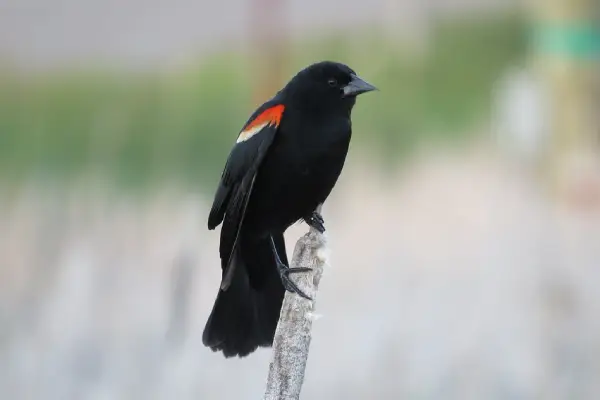
- Scientific name: Agelaius phoeniceus
- Lifespan: 2 years in the wild
- Wingspan: 12-16 in
Red-winged blackbirds are small birds that can weigh as little as 1.5 oz. They are sexually dimorphic species, males and females look different.
Male red-winged blackbirds are easily identified by their completely black color and red epaulets that are edged in yellow. They often make red-shoulder displays and emit rich and scratchy “oak-a-lee” songs.
Females are smaller, streaky brown above, and paler below. They have a scolding chatter that sounds like “chit chit cheer teer teer teerr.”
Red-winged blackbirds can be seen year-round in Western Washington and are common in riparian habitats and fields. They breed in the state from early spring to mid-summer, usually around wetlands. During winter, they can be seen around agricultural areas.
Their scientific name “agelaios” means “gregarious,” while the “phoeniceus” means “crimson” or “red,” which perfectly describes these birds.
Red-winged blackbirds are one of North America’s most abundant birds as during the nonbreeding season scientists occasuonally discover flocks that consist of over a million birds.
They are also very territorial and polygynous birds and a single male can have up to 10 different females making nests in his territory.
Females, on the other hand, will frequently mate with other males, and often lay eggs of mixed paternity. They will have a clutch of three to four pale blue-green eggs with dark streaks.
Red-winged blackbirds are omnivores and feed on insects, seeds, and grain.
There are over 20 subspecies of red-winged blackbirds.
Red-winged blackbirds are also on our list of the smallest black birds.
Cedar Waxwing

- Scientific name: Bombycilla cedrorum
- Lifespan: up to 8 years
- Wingspan: 9-12 in
Cedar waxwings are sleek medium-sized birds that have large heads and crests, black facial masks, and short necks and beaks. They are easy to identify by the pale brown color of the head, soft gray color on the wings, pale yellow bellies, and gray tails with bright yellow tips.
If the bird eats enough of the honeysuckle fruit while it is growing, the tip of the tail will turn from yellow to orange.
Cedar waxwings can be found in the western parts of Washington throughout the year and are common around forests, woodlands wetlands, residential areas, and orchards. The best time to see them in Washington would be from May to September.
These yellow-tailed birds got their name from the waxy red tips on their secondary wing feathers.
Cedar waxwings are one of the few North American birds that can survive eating only fruit for several months. Scientists recorded many cases of them getting drunk from eating too much of the fermented fruit.
Cedar waxwings are monogamous and both partners will build a nest of grass, twigs, bark, and hair. The female will have a clutch of 4-5 eggs that she incubates while the male feeds her. After that, both parents take care of the young.
Anna’s Hummingbird
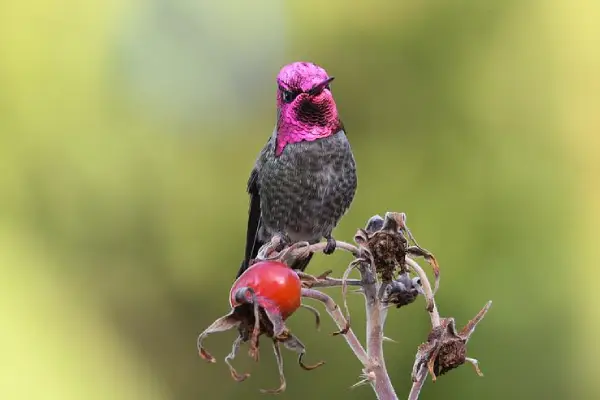
- Scientific name: Calypte anna
- Lifespan: 8.5 years
- Wingspan: 4.7 in
Out of the 4 species of hummingbirds found in the state, only Anna’s hummingbirds can be seen year-round in Western Washington; the other hummingbirds depart by October.
Anna’s hummingbirds are medium-sized and stocky hummingbirds with straight, shortish beaks, and fairly broad and forked tails.
You will identify them by their iridescent bronze-green backs, pale grey chests and bellies, and green flanks. Males have iridescent reddish-pink heads and gorgets that extend to the sides of the neck and throats. Females are grayish and have green heads with a small amount of red on their throats.
Look for them around woodlands, suburban parks, gardens, and coastal valleys.
Using their long tongues, Anna’s hummingbirds feed on flower nectar. They also eat some small insects they catch mid-flight and often visit bird feeders.
In the early 20th century, Anna’s hummingbirds only bred in northern Baja California and southern California. They have expanded their breeding range since.
Scientists estimate that Anna’s hummingbirds have a population of around 1.5 million individuals.
These small birds got their name from Anna Masséna, the Duchess of Rivoli.
Red-tailed Hawk
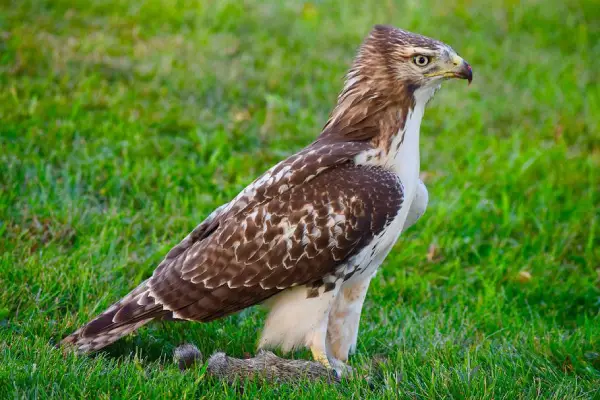
- Scientific name: Buteo jamaicensis
- Lifespan: 10-15 years
- Wingspan:43-55.5 in
Red-tailed hawks are large birds with broad rounded wings and short wide tails. There are several variations of their colors; most are brown with light bellies, streaky breast bands, and rusty tails. Females tend to be larger than males.
Red-tailed hawks are birds of prey that can be seen throughout the year in Western Washington in almost every habitat with open areas and patches of trees or other elevated perches.
You will often see them sitting perched near a roadside or soaring in the sky and looking for prey. They can spot a mouse from 100 feet in the air and will grab it using their almost inch-and-a-half-long talons.
Red-tailed hawks are carnivores that feed on small mammals, especially rodents and rabbits, birds, reptiles, occasionally fish, and large insects.
These raptors are monogamous and in western Washington, they will usually nest in a hardwood tree, especially black cottonwood or red alder.
Red-tailed hawks are legally protected in the United States by the Migratory Bird Treaty Act and you can’t hunt them.
There are 14 subspecies of red-tailed hawks.
Barn Owl
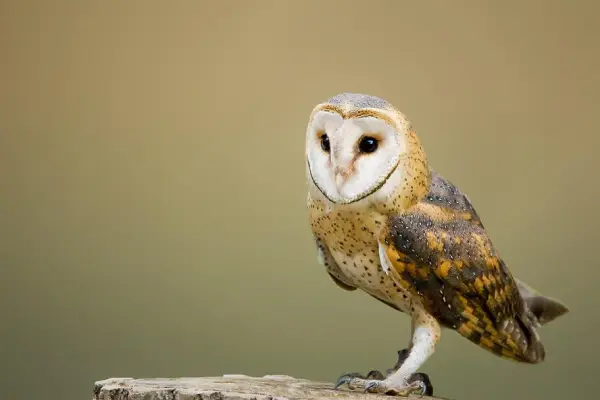
- Scientific name: Tyto alba
- Lifespan: 4 years
- Wingspan: 31-37 in
Barn owls are one of the most widely distributed species of owl in the world. They can be recognized by their straw-colored plumage above that is white below, dark eyes, and heart-shaped facial discs. Both sexes look similar; females are slightly larger.
Barn owls are nocturnal raptors that are common around open country, wetlands, and farms of Western Washington and can be seen there year-round. During winter, they will roost in dense conifers or barns.
Barn owls will often perch on branches, fence posts, or other lookouts and scan their surroundings.
Unlike some other species of owl, barn owls do not hoot and make a piercing eerie “shree” scream.
They hunt animals on the ground which they locate by sound, thanks to their acute hearing but also excellent eyesight. They will swallow their entire prey and several times a day spit out pellets of fur and undigested material.
Barn swallows are monogamous, stay together for life, and the female will lay and incubate 2-11 eggs while the male brings her food.
Osprey

- Scientific name: Pandion haliaetus
- Lifespan: 15-20 years
- Wingspan: 50–71 in
Ospreys are huge birds of prey that are unmistakable when seen up close. They are brown above and white below, have black facial masks, white tails with fine dark crossbars, and yellow eyes.
Ospreys can be seen from spring to fall in Western Washington, around lakes, rivers, and coastal bays. The best time to see them in the state is from April to September as they migrate south to winter.
Ospreys are piscivorous and fish makes up 99% of their diet hence the nicknames “sea hawks” or “fish hawks”.
They have a special reversible outer toe that allows them to grasp with two toes in front and two behind. Such adaptation prevents fish from slipping away.
They will hover above the water, locate their prey and then swoop down for the capture with their talons extended.
During their 20-year-long lifetime, these migratory birds can travel over 160,000 miles.
Ospreys nest near water, on top of dead trees, and use branches, sticks, twigs, moss, and fish bones as material. The female will have a clutch of 3 eggs that both partners incubate.
Bald Eagle

- Scientific name: Haliaeetus leucocephalus
- Lifespan: 20-30 years
- Wingspan: 70.8-90.5 in
Bald eagles are the national bird of the United States and one of the largest birds of prey in North America. They are not actually bald; their name comes from the old English word “balde” which means white.
Bald eagles are mostly brown with white heads, tails, and eyes; they have yellow beaks and talons. However, before attaining these characteristics around the age of five, they are mostly dark brown with varying amounts of white mottling.
Bald eagles nest primarily along marine shorelines and major rivers in Western Washington. That part of the state has one of the largest concentrations of bald eagles in North America.
They can be seen there throughout the year, especially in the San Juans and other northern Puget Trough islands and along both the north and west coasts of the Olympic Peninsula.
Bald eagles build the largest nests of any North American bird that can be up to 13 ft deep and 8.2 ft wide.
These magnificent raptors are hard to miss as they soar through the air with their 7.5-foot-wide wings.
They are carnivores and opportunistic feeders that mostly consume fish, which they snatch from the water with their sharp talons.
Bald eagles are also one of the largest birds found in Ohio, Michigan, and Florida.
Northern Flicker
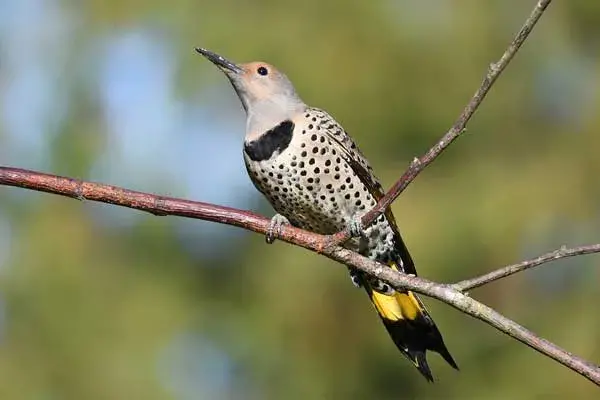
- Scientific name: Colaptes auratus
- Lifespan: up to 9 years
- Wingspan: 16.5-20 in
Northern flickers are large brown woodpeckers that are native to the United States and among the few that migrate, although not the ones from Washington.
There are 9 subspecies of the northern flickers. Two are present in Washington, the red-shafted, and the less common yellow-shafted.
Adult northern flickers are easy to recognize by the brown plumage with black bars on the backs and wings. During the flight, these birds will flash the red-orange color under their wings and tails.
Northern red-shafted flickers can be seen year-round in Western Washington around woodlands, open areas, suburban lawns, parks, and grasslands. They do not migrate from the state.
They are also the state bird of Alabama and are known as yellowhammers.
Northern flickers are one of the most common woodpeckers in Washington that play an important role in the ecosystem – they make nesting and roosting holes in the trees that other birds, animals, and reptiles use.
Although they eat fruits, berries, seeds, and nuts, northern flickers’ primary food is insects, with ants making almost 50% of their diet.
Scientists once discovered over 5,000 ants in one flicker’s stomach!
The oldest ever recorded northern flicker was over 9 years old when discovered in Florida.
Tundra Swan
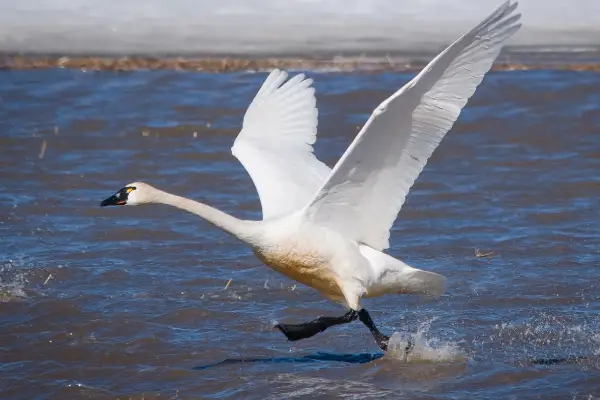
- Scientific name: Cygnus columbianus
- Lifespan: 10 years
- Wingspan: 66-83 in
Tundra swans are large white birds with long necks, black beaks and legs, dark eyes, and yellow “teardrops” in front of the eyes. Males and females look alike.
Tundra swans can be seen from fall to spring in Western Washington, commonly around wetlands and fields. They migrate to the state from the Alaska Peninsula and the best time to see them is from November to March.
Tundra swans are the most numerous of the North American swans and are nicknamed “whistling” because of the sound their wing flapping produces.
They become very aggressive and territorial during the breeding season; in other parts of the year, tundra swans are rather social birds.
These large Western Washington birds are monogamous and mate for life. They will build nests near lakes and other open waters and both parents will participate in construction. The female will incubate 4-5 eggs while the male helps; both parents will raise the young.
Tundra swans are omnivores and mainly feed on aquatic plants and roots, some arthropods, worms, and shellfish.
Black Oystercatcher

- Scientific name: Haematopus bachmani
- Lifespan: 10-14 years
- Wingspan: 28-36 in
Black oystercatchers are large shorebirds that are common on the shoreline of western North America. They can be identified by their all-black plumage, long red beaks, pink legs, red eyes, and red rings around them.
Black oystercatchers are permanent residents of rocky shorelines of Western Washington and can be seen there year-round. They do not migrate and usually stay near their nesting areas.
They have razor-sharp beaks they use to pry open oysters and other bivalves for food, hence the name “oystercatcher”.
Oystercatchers are social birds that can be often seen during the day foraging, preening, resting, and sunbathing.
They have a global population of around 10,000 individuals; around 400 of those are estimated to live in Washington.
Part of their scientific name, “bachmani,” is after John Bachman, the friend of naturalist John James Audubon that named the species.
Caspian Tern

- Scientific name: Hydroprogne caspia
- Lifespan: 12 years
- Wingspan: 50–57 in
Caspian terns are the biggest terns in the world. They are easily recognizable by their enormous heads, coral red beaks, shallowly forked tails, and deep, raspy calls. They are white overall with pale gray upperwings.
In the state, Caspian terns mostly nest in the Columbia River estuary, in the Wahkiakum and Pacific counties of Western Washington. They leave the state around October and return around late March so the best time to see them would be from April to August.
Caspian terns got the name from the early associations with the Caspian Sea where they are fairly common even today.
These terns are very aggressive when defending their breeding colony. They will pursue, attack, and chase away potential predatory birds, and even bite people on their heads if they invade their space.
Caspian terns will often hover high over the water, scanning for fish. When they spot one, they will fly down rapidly and dive to catch it. They also occasionally feed on large insects, the young and eggs of other birds, and some rodents.
Ring-billed Gull
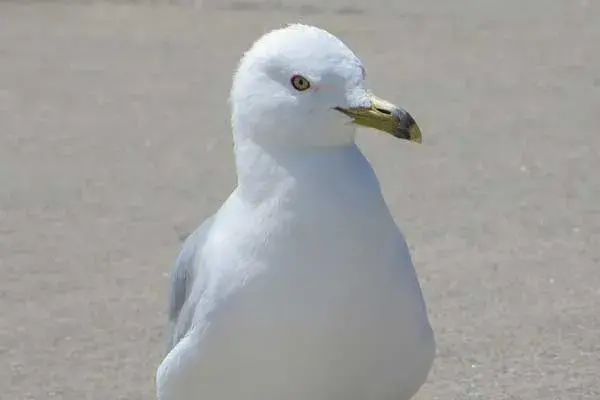
- Scientific name: Larus delawarensis
- Lifespan: 11 years
- Wingspan: 41.3-46.1 in
Ring-billed gulls are medium-sized gulls with white bodies, gray wings, yellow eyes, and yellow legs. They got their name from the dark rings on their relatively short beaks.
In Western Washington, some populations of ring-billed gulls can be seen during winter, some during summer, while others might stay there year-round. During winter, ring-billed gulls are most common in coastal areas and the Puget Trough.
They are often called the “fast food gulls” because they can be often seen around fast-food restaurants scavenging for food.
Ring-billed gulls are omnivores and also feed on insects, fish, grain, eggs, earthworms, and rodents.
They will nests in colonies generally on small islands and lay three eggs that both parents incubate.
Wood Duck
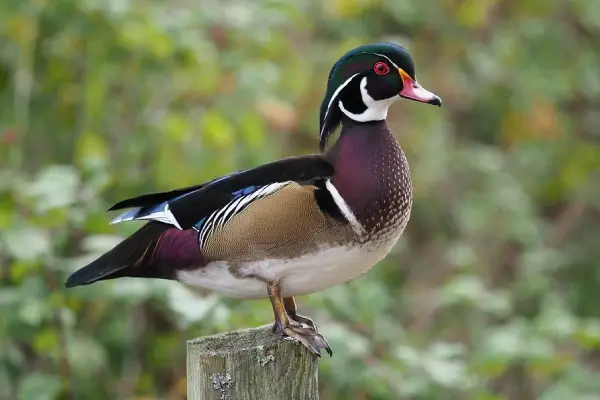
- Scientific name: Aix sponsa
- Lifespan: 3-4 years
- Wingspan: 26-29 in
Wood ducks are also known as Carolina ducks. They are one of the most colorful North American waterfowl. Males are multicolored and have red eyes; females are grayish brown and have white eyerings and blue speculum. Both sexes have crests on their heads.
Wood ducks are common throughout the year around river riparians, wooded marshes, and parks of Western Washington. They breed there from March through August, especially in lowlands west of the Cascades.
Listen for the male’s rising whistle “jeee” call or the female’s drawn-out, rising squeal that sounds like “do weep do weep.”
Wood ducks usually nest in cavities in trees close to water; if you put a nesting box, you might be able to attract a pair.
Wood ducks have a clutch of 7-15 white-tan eggs and they are the only North American ducks that can produce two broods in one season.
They are omnivores and feed on nuts, seeds, vegetables, berries, and insects.
Belted Kingfisher
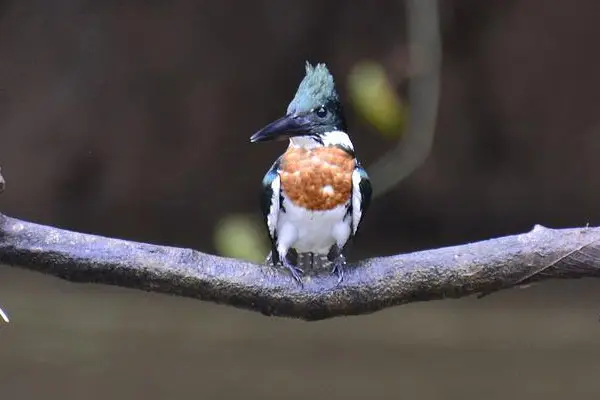
- Scientific name: Megaceryle alcyon
- Lifespan: 6-14 years
- Wingspan: 19-23 in
Belted kingfishers are stocky water kingfishers that are native to North America. They are easy to identify by their large heads, shaggy crests on the top and back of their heads, and straight, thick, pointed beaks.
Males are slate blue with white underparts. Uncommon for many birds, female belted kingfishers have more bright blue colors with orange patches on the bellies and flanks.
Belted kingfishers are common around wetlands, rivers, streams, and the coast of Western Washington throughout the year.
It is easier to hear than to see belted kingfishers, they have a distinct and loud rattling or chattering call.
They have two fused toes which can also help distinguish these blue-winged birds from others.
These birds are also common in Southern California and can be very territorial – males will often charge at and chase intruders away.
Belted kingfishers are carnivores that dive to catch fish and crayfish with their heavy beaks; they also feed on mollusks, crustaceans, amphibians, and lizards.
They can’t digest bones, so just like owls, belted kingfishers will regurgitate the undigested pieces as pellets.
Summary
This concludes our list of birds in Western Washington.
There are many types of Western Washington birds including several types of songbirds, raptors, woodpeckers, hummingbirds, owls, ducks, and many others.
Next time you see any of these birds in person, you should be able to recognize them with ease!
And if you enjoyed our article, here are our other popular reads on birds: List of small blue-colored birds and List of birds with green-colored heads